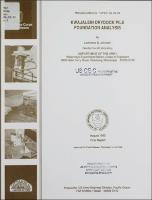Please use this identifier to cite or link to this item:
https://hdl.handle.net/11681/10355| Title: | Kwajalein drydock pile foundation analysis |
| Authors: | United States. Army. Corps of Engineers. Pacific Ocean Division Johnson, Lawrence D. |
| Keywords: | Coral sands Driver piles Pile capacity Pile load test Piling Dry docks Foundations Kwajalein Island Pacific Ocean |
| Publisher: | Geotechnical Laboratory (U.S.) Engineer Research and Development Center (U.S.) |
| Series/Report no.: | Miscellaneous paper (U.S. Army Engineer Waterways Experiment Station) ; GL-92-23. |
| Description: | Miscellaneous Paper Abstract: The MCA 9206180 dry dock facility being constructed on Kwajalein Island of the Marshall Islands is to be supported by 12 groups of driven piles, 6 groups supporting each side of the dry dock. Each group contains 12 piles. Soil investigation reports of the calcareous coral sands and static pile load tests conducted near the headwall (landside of the dry dock) indicated that 20 in. by 20 in. by 85 ft long precast prestressed concrete piles embeded to a depth of 53 ft will adequately support the drydock. Driving records of the production piles indicated that the penetration resistances of the piles at the final embedment depth became substantially less than expected as piles were driven further toward the lagoon end of the dry dock area. The penetration resistance N required for adequate bearing capacity using a Delmag 46-23 hammer rated at 60 kip-ft was determined to be 12 blows/ft at the final toe (tip) elevation, but the actual N decreased to as low as 2 blows/ft for piles driven near the lagoon end of the dry dock. The lower than expected penetration resistances observed during driving of the production piles were attributed to several mechanisms that include generation of excess pore pressures as a result of driving, encounter of loose (weak) sands or sands less dense at the lagoon end compared with those near the headwall, and destruction of cementation bonds in the coral sands. The capability of the pile foundation to adequately support the dry dock could not be determined from the static load test results performed on piles driven near the headwall and from other existing data. The prudent course of action was to complete a supplemental field investigation of the offshore production piles. This investigation was conducted 7 months after the installation of the pile foundation and included a static load test, the driving of an indicator pile, and the restrikes of 10 of the production piles. The results of this investigation showed that the pile foundation has adequate bearing capacity to support the dry dock. The 7-month delay before initiating the supplemental test program permitted dissipation of any excess pore pressures. Evidence was found indicating that driving of the production piles had dens ified the sands and could have contributed to generation of excess pore pressures. The delay prior to the supplemental investigation also could have provided time for a recementation mechanism to occur (or to at least begin) in the coral sands. |
| Rights: | Approved for public release; distribution is unlimited. |
| URI: | http://hdl.handle.net/11681/10355 |
| Appears in Collections: | Miscellaneous Paper |
Files in This Item:
| File | Description | Size | Format | |
|---|---|---|---|---|
| MP-GL-92-23.pdf | 8.61 MB | Adobe PDF |  View/Open |